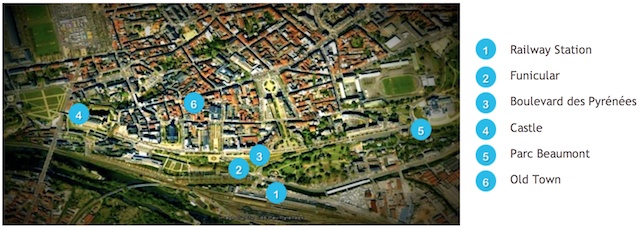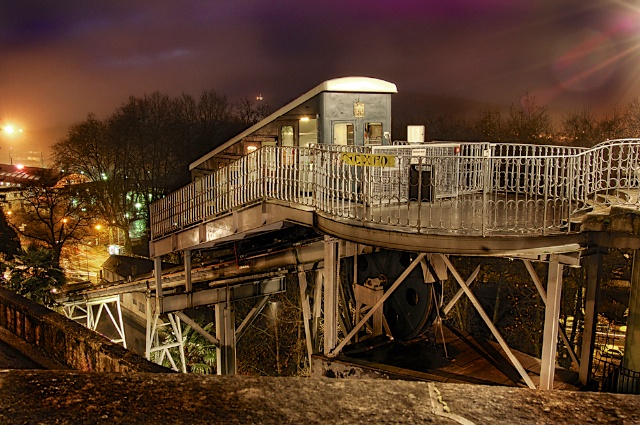The charming town of Pau is located in the South-West of France, 200 kilometres from Bordeaux and Toulouse. Many visitors, particularly from Britain, are attracted by the mild climate. In the 19th century, many wealthy Britons and Americans enjoyed Pau as a winter retreat and made their mark on the city by building grand villas and designing English-style parks and gardens.

From the Gave de Pau River to the Boulevard des Pyrénées

The river which crosses Pau is named after the town. The Gave de Pau has its source at the famous Cirque de Gavarnie in the Pyrenees and flows over 180 km through Lourdes, Pau and Orthez before flowing into the Adour River.
The railway station is located at the bottom of the valley between the Pau River and the Heid Canal. Nearby, the old-fashioned (and free) cliff railway, built in 1908, eases the steep ascent to the old town. The creaky train clangs up the hill arriving at the celebrated Boulevard des Pyrénées.

This 1.8 km long street stretching from the castle to Beaumont Park was made famous by a saying from French writer Lamartine:
“Pau est la plus belle vue de terre du monde comme Naples est la plus belle vue de mer.”
(Pau has the world’s most beautiful view from land just as Naples has the most beautiful view from the sea).
Running along the crest of the hill above the valley of the Gave de Pau River, the superb promenade offers one of the finest panoramic views over the snow-dusted peaks of the Pyrenees.
The castle of Pau

Pau’s most famous monument is its castle which dominates the old town. The castle was built on top of a small hill overlooking the River Gave de Pau, on the outskirts of the old market town. The castle became the royal birthplace of Henry IV, King of France and Navarre.

The region underwent three major restorations: in the Middle Ages, during the Renaissance and then in the middle of the 19th century.

Below the castle, the Tour de la Monnaie, made from brick and stone, contains a free lift that leads to the top of the ramparts.
It houses a national museum displaying artefacts comprising 800 years of history, including one of the most beautiful collections of tapestries in Europe.
The surrounding park and gardens offer fine views over the valley and the Pyrenees.
The Old Town of Pau

Close to the castle, the old part of town features ancient and narrow streets which have kept their medieval characteristics. The area is not extensive however is worth a stroll to admire the restored medieval and Renaissance townhouses. The area is well maintained and the old buildings have been preserved as much as possible. There are numerous cafés, restaurants, bars and boutiques, with the main Saturday markets held in the halls on Place de la République located to the north east of the old town.

With the suburban expansion, local neighbourhoods and gardens also offer many interesting architectural and landscaped heritage items. Comprising varying architectural styles, some buildings have become cornerstones of the old town (Le Gassion, l’Hôtel de France, place Gramont, Boulevard des Pyrénées). They have become tourist attractions for the city because of their quality and influence. Besides these main attractions, lots of interesting buildings can be found, exemplifying the art of simplicity, humility and good proportion with many stylish details.
Pau: a real garden city

Pau houses many public gardens. The National Garden surrounds the castle and huge parks comprising several varietal species adorn the city, which enjoys a sunny climate. Rare trees, exotic vegetation, a palm grove, royal gardens and hidden gems populate the area.
Pau is a good base from which to explore the Pyrenees and is a gateway to the five Béarnaise valleys: Ossau Valley, Aspe Valley, Barétous Valley, Ouzom Valley and Vath-Vielha where famous spa towns and popular winter resorts are located. One worthwhile excursion from Pau, especially for families, is to the Grottes de Bétharram. Around spectacular stalactites and stalagmites, it is possible to sail a barge in the caves on an underground lake.
Visit the official website of the Tourist Board of Pau.
Featured image: Pau Castle © flavia.mounier – licence [CC BY-SA 3.0] from Wikimedia Commons

![Pau Castle © flavia.mounier - licence [CC BY-SA 3.0] from Wikimedia Commons](https://frenchmoments.eu/wp-content/uploads/2012/11/Pau-Castle-©-flavia.mounier-licence-CC-BY-SA-3.0-from-Wikimedia-Commons.jpg)



I am about to marry into the La Campagne family and i cannot find a family crest to reproduce for my wedding ring. The Lacampagnes are from Pau France. I am also interested in learning the original language of Pau. Can someone help me?
Hi Nora, thank you for contacting us! Honestly I don’t really know what to suggest to help you in your search. Maybe you can contact someone more local (I live in the Alps) like the Tourist Office of Pau: http://www.pau-pyrenees.com. Their email is accueil@tourismepau.fr
They may lead you to another contact in the Pau region that can help you! All the best! Pierre